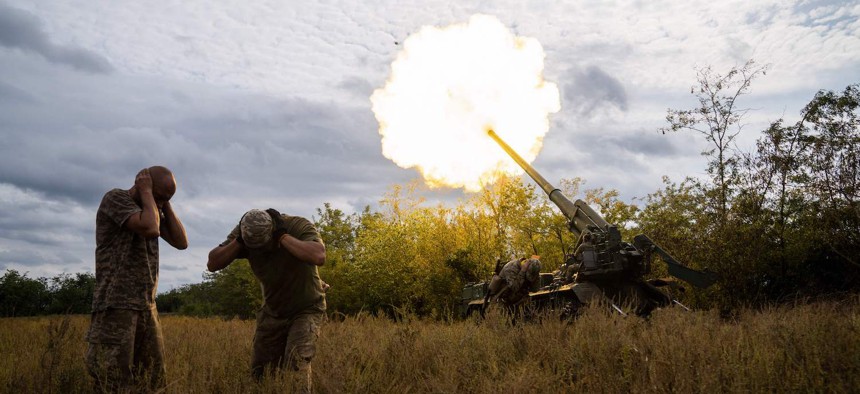
Ukrainian artillerymen fire a self-propelled 203mm cannon "2s7 Pion" on the southern frontline of Ukraine on September 15, 2022. AFP via Getty Images / IHOR TKACHOV
Ukraine: Russia’s Draft, Setbacks Mean It’s Time for More Advanced Weapons
Kyiv’s winter wishlist includes long-range artillery, armored Humvees, kamikaze drones, and more.
Russian President Vladimir Putin’s decision to call up 300,000 reservists should prod the West to send the longer-range artillery and more technologically advanced weapons that Kyiv will need to press its advantage in the harsh winter months ahead, Ukraine’s deputy defense minister said Wednesday.
Volodymyr Havrylov’s list is topped by the ATACMS, a missile that can outrange the artillery rockets Ukraine is currently using, and fighter jets, which Washington has been reluctant to provide out of fear that Russia would escalate the nearly seven-month-old war.
“I think after today's announcement [by] Putin, we are closer to a political decision here in Washington, D.C., that Ukraine deserves and really needs to be provided with ATACMS,” Havrylov said at a conference sponsored by the National Defense Industrial Association in Austin, Texas.
Ukraine’s highly successful use of the High Mobility Artillery Rocket System, known as HIMARS, has prompted the Russians to move its ammunition depots and logistics hubs more than 100 kilometers from the front lines, Havrylov said. That places them out of the range of HIMARS.
“If we had a capability to destroy the targets of the depots to 100 kilometers [away], it would be a total disaster for Russia,” he said. “That's why we're asking for ATACMS,” which has a published range of 300 km.
U.S. officials worry that Ukraine would use long-range artillery to strike inside of Russia, which Moscow has said would draw escalation. Ukrainian officials have said they need the longer-range missiles to liberate their own territory occupied by Russian forces.
“They see it as a threat in case we use it against Russian territory. We [are] arguing that we are not going to use it against Russian territory, because we have a lot of targets on our occupied territory, including Crimea,” said Havrylov, a former major general and defense attache to the United States.
Speaking in English at the defense-contractor-heavy conference and using phrases and acronyms often used by U.S. military officials, Havrylov also called for armored Humvees; and electronic warfare, counter-drone, and anti-missile systems.
“This war [will] be won only through technological superiority not by numbers of people, not by numbers of artillery,” he said.
Havrylov also called for “Stinger-type air defense,” a reference to the U.S.-provided shoulder-fired rockets.
He also said Ukraine needs anti-tank weapons with a longer range than the Javelin anti-tank missile. “Javelin is okay, but it's only two-and-a-half kilometers’ range,” and Russian tanks have become careful to stay farther away, Havrylov said. “For us to reach them, we need to find something else like drones, kamikaze drones, or … anti-tank systems with a range up to six kilometers.”
He said, “We started to receive something from the United States as well,“ but did not specify what.
The U.S. has given Ukraine Phoenix Ghost drones, which can loiter before crashing into a target.
“Winter also is a window of opportunity for [our] military,” Havrylov said. With the “right armament and equipment, we can also succeed more during the wintertime.”
He added: “Some people here [in the United States] and in Europe still think that Russia is a sleeping bear. But in fact, is a frightened jackal, in a bear's skin.”
Before traveling to Austin for Wednesday’s conference, Havrylov said he met with U.S. Defense Department acquisition and policy officials, who are “very supportive.”
Ukraine also needs help maintaining battle-damaged weapons. Havrylov said the military prefers to do the repairs inside Ukraine, which he acknowledged creates a challenge. With the proper technical documentation and training, Ukrainian engineers could do some repairs.
“Our military prefers to do maintenance on the territory of Ukraine — not to send damaged equipment outside because it takes a lot of effort and time with logistics,” he said.
Early in the war, 20 to 30 percent of weapon malfunctions were caused by inadequate training, Havrylov said. At the conference, contractors discussed using conducting training over video conferencing apps. U.S. troops in Poland are currently using chat rooms to help.




